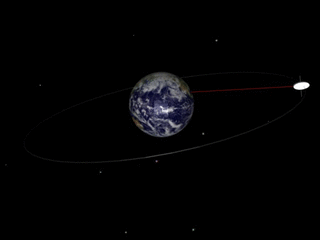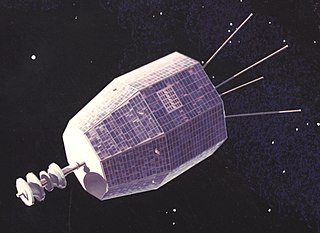
A geosynchronous orbit is an Earth-centered orbit with an orbital period that matches Earth's rotation on its axis, 23 hours, 56 minutes, and 4 seconds. The synchronization of rotation and orbital period means that, for an observer on Earth's surface, an object in geosynchronous orbit returns to exactly the same position in the sky after a period of one sidereal day. Over the course of a day, the object's position in the sky may remain still or trace out a path, typically in a figure-8 form, whose precise characteristics depend on the orbit's inclination and eccentricity. A circular geosynchronous orbit has a constant altitude of 35,786 km (22,236 mi).

A communications satellite is an artificial satellite that relays and amplifies radio telecommunication signals via a transponder; it creates a communication channel between a source transmitter and a receiver at different locations on Earth. Communications satellites are used for television, telephone, radio, internet, and military applications. Many communications satellites are in geostationary orbit 22,300 miles (35,900 km) above the equator, so that the satellite appears stationary at the same point in the sky; therefore the satellite dish antennas of ground stations can be aimed permanently at that spot and do not have to move to track the satellite. Others form satellite constellations in low Earth orbit, where antennas on the ground have to follow the position of the satellites and switch between satellites frequently.
Syncom started as a 1961 NASA program for active geosynchronous communication satellites, all of which were developed and manufactured by the Space and Communications division of Hughes Aircraft Company. Syncom 2, launched in 1963, was the world's first geosynchronous communications satellite. Syncom 3, launched in 1964, was the world's first geostationary satellite.

A very-small-aperture terminal (VSAT) is a two-way satellite ground station with a dish antenna that is smaller than 3.8 meters. The majority of VSAT antennas range from 75 cm to 1.2 m. Bit rates, in most cases, range from 4 kbit/s up to 16 Mbit/s. VSATs access satellites in geosynchronous orbit or geostationary orbit to relay data from small remote Earth stations (terminals) to other terminals or master Earth station "hubs".

The Relay program consisted of Relay 1 and Relay 2, two early American satellites in elliptical medium Earth orbit. Both were primarily experimental communications satellites funded by NASA and developed by RCA. As of December 2, 2016, both satellites were still in orbit. Relay 1 provided the first American television transmissions across the Pacific Ocean.

Delta is an American versatile family of expendable launch systems that has provided space launch capability in the United States since 1960. Japan also launched license-built derivatives from 1975 to 1992. More than 300 Delta rockets have been launched with a 95% success rate. Only the Delta IV Heavy rocket remains in use as of November 2020. Delta rockets have stopped being manufactured in favor of Vulcan.

STS-51-I was the 20th mission of NASA's Space Shuttle program and the sixth flight of Space Shuttle Discovery. During the mission, Discovery deployed three communications satellites into orbit. The mission launched from Kennedy Space Center, Florida, on August 27, 1985, and landed at Edwards Air Force Base, California, on September 3, 1985.

Commercial use of space is the provision of goods or services of commercial value by using equipment sent into Earth orbit or outer space. This phenomenon – aka Space Economy – is accelerating cross-sector innovation processes combining the most advanced space and digital technologies to develop a broad portfolio of space-based services. The use of space technologies and of the data they collect, combined with the most advanced enabling digital technologies is generating a multitude of business opportunities that include the development of new products and services all the way to the creation of new business models, and the reconfiguration of value networks and relationships between companies. If well leveraged such technology and business opportunities can contribute to the creation of tangible and intangible value, through new forms and sources of revenue, operating efficiency and the start of new projects leading to multidimensional positive impact. Examples of the commercial use of space include satellite navigation, satellite television and commercial satellite imagery. Operators of such services typically contract the manufacturing of satellites and their launch to private or public companies, which form an integral part of the space economy. Some commercial ventures have long-term plans to exploit natural resources originating outside Earth, for example asteroid mining. Space tourism, currently an exceptional activity, could also be an area of future growth, as new businesses strive to reduce the costs and risks of human spaceflight.

Marisat satellites were the first maritime telecommunications satellites and were designed to provide dependable telecommunications for commercial shipping and the U.S. Navy from stable geosynchronous orbital locations over the three major ocean regions. The three Marisat satellites, F1, F2, and F3, were built by Hughes Aircraft Corporation (HAC) for COMSAT Corporation starting in 1973. The satellites were designed to provide maritime telecommunications services in three large ocean areas, the Atlantic Ocean, the Pacific Ocean, and the Indian Ocean, and were located at 72.5° East longitude, 176.5° E, and 345° E in the geosynchronous orbital arc. The three-satellite Marisat system served as the initial INMARSAT constellation.

Telstar is the name of various communications satellites. The first two Telstar satellites were experimental and nearly identical. Telstar 1 launched on top of a Thor-Delta rocket on July 10, 1962. It successfully relayed through space the first television pictures, telephone calls, and telegraph images, and provided the first live transatlantic television feed. Telstar 2 was launched May 7, 1963. Telstar 1 and 2—though no longer functional—still orbit the Earth.
Intelsat II F-2, also known as Lani Bird, was a communications satellite operated by Intelsat. Launched in 1967, it was operated in geostationary orbit at a longitude of 174 degrees east until 1969.
Intelsat II F-3, also known as Canary Bird was a communications satellite operated by Intelsat. Launched in 1967 it was operated in geostationary orbit, spending most of its operational life at a longitude of 15 degrees west.
Intelsat IV F-1 was a geostationary communication satellite built by Hughes, it was owned by Intelsat. The satellite was based on the HS-312 platform and its estimated useful life was 7 years.
Intelsat IV F-2 was a geostationary communication satellite built by Hughes and owned by Intelsat. The satellite was based on the HS-312 platform and its estimated useful life was 7 years.
Intelsat IV F-4 was a geostationary communication satellite built by Hughes, it was owned by Intelsat. The satellite was based on the HS-312 platform and its estimated useful life was 7 years.

Intelsat IV F-5 was a geostationary communication satellite built by Hughes, it was owned by Intelsat. The satellite was based on the HS-312 platform and its estimated useful life was 7 years.
Intelsat IV F-6 was a geostationary communication satellite built by Hughes, it was owned by Intelsat. The satellite was based on the HS-312 platform and its estimated useful life was 7 years.
Intelsat IV F-7 was a geostationary communication satellite built by Hughes, it was owned by Intelsat. The satellite was based on the HS-312 platform and its estimated useful life was seven years.
Intelsat IV F-8 was a geostationary communication satellite built by Hughes, it was owned by Intelsat. The satellite was based on the HS-312 platform and its estimated useful life was 7 years.










